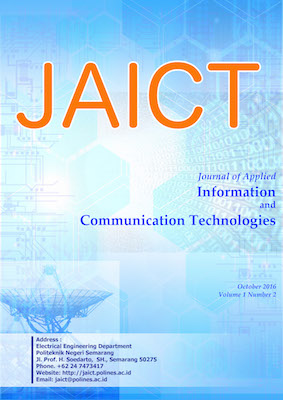Design of E-KTM Based On Contactless Smartcard for Access Electro Department Parking Service State Polytechnic of Semarang
DOI:
https://doi.org/10.32497/jaict.v1i2.445Keywords:
Information TechnologyAbstract
E-KTM is an electronic student identification (card ID) card which function besides to student identity, it can be used to access several services at State Polytechnic of Semarang such as to access parking service. In this research, E-KTM has used contactless smart card technology will be used to access facilities parking at electro department area parking. The gate of parking area will be installed two barrier gate to entrance and exit. To access this parking facility, E-KTM must be attached to RFID reader near the entrance gate, and then the barrier gate could open. The system controlled with microcontroller arduino Mega 2560 and will automatically take and save the data of the card ID in database system, and then the infrared sensor would detected the object and a few minutes the barrier gate closed. The system also works for the exit. While the performance to determine average service time with results 2.927 open time and 2.913 close time 2.95 seconds for entrance gate and 2.792 open time and 2.789 close time for exit gate.
Index Terms””E-KTM card ID, Parking service, database system
References
Radio Frequency Identification Technology inii Federal Government. http://www.gao.gov/new.items/d05551.pdf. Access 23 Mai 2016.
Prinsip Kerja RFID, http://RFID-handbook.com. Access 22 Mai 2016
Rankl,Woflgang, Effing, Sart card Handbook Third Edition.S.1. John Wiley & Sons,Ltd.2003
Arduino. https://www.arduino.cc/en/main/ArduinoBoardMega2560. Access 20 Mai 2016
Ethernet Shield. https:// www.arduino.cc /en/Main/ Arduino Ethernet Shield. Access 20 mai 2016.
Downloads
Published
Issue
Section
License
Authors who publish with this journal agree to the following terms:Authors retain copyright and grant the journal right of first publication with the work simultaneously licensed under a Creative Commons Attribution License that allows others to share the work with an acknowledgement of the work's authorship and initial publication in this journal.
Authors are able to enter into separate, additional contractual arrangements for the non-exclusive distribution of the journal's published version of the work (e.g., post it to an institutional repository or publish it in a book), with an acknowledgement of its initial publication in this journal.
Authors are permitted and encouraged to post their work online (e.g., in institutional repositories or on their website) prior to and during the submission process, as it can lead to productive exchanges, as well as earlier and greater citation of published work (See The Effect of Open Access).






